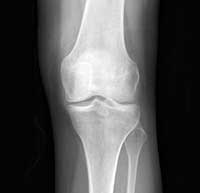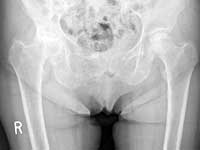Making the transition: Orthopedists contemplate the switch to digital X-rays
The digital format offers sharper images, electronic transmission and minimal file storage.
![Frederick R. Fischer [photo]](/~/media/images/news/print/orthopedics-today/2005/06_june/frederick_70_90_3414.jpg) --- Frederick R. Fischer
--- Frederick R. Fischer
A growing number of orthopedic practices are making the transition from traditional film X-rays systems to a digital X-ray format.
The advantages include improved efficiency, less storage and higher-quality images, although integrating the necessary computer infrastructure into a practice can be costly in the first few years.
Consequently, orthopedic surgeons should give careful consideration to the imaging needs of their practices and whether they have the patient volume to justify making the transition to computed radiography (CR), said Kishore Tipirneni, MD, with Phoenix Orthopaedic Consultants in Glendale, Ariz.
“There are differences between the quality of images that a digital X-ray system can produce and those that come from traditional [film] X-rays. Still, it’s a big switch for many people, and taking on something new like this can be overwhelming if you don’t know what to consider for your specific practice,” said Tipirneni, who discussed the pros and cons of setting up a digital X-ray system in an instructional course lecture at the American Academy of Orthopaedic Surgeons 72nd Annual Meeting.
Advantages
COURTESY OF STEFAN KREUZER |
He said there is improved efficiency with digital imaging, no lost X-ray films and fewer retakes of images. “We have the ability to adjust the window/level of the digital image, which enables us to improve the resolution and overall clarity of what we are looking at,” he said. “We can’t do that with film.”
Frederick R. Fischer, vice president of AllPro Imaging Inc., also sees advantages to using CR.
“There are two classes of advantages to using CR: convenience and money savings, and better diagnostics,” he said. “Imagine eliminating the cost of X-ray film, processing chemicals and disposal of the used chemicals, and imagine eliminating the film processor and smelly darkroom along with the cost of processor cleaning and repair. Add to that the fact that you don’t need film storage racks and film duplication.”
Likewise, working conditions in the office can improve with the addition of CR, Fischer said.
“For example, if a patient requests copies of his or her X-rays, with CR, they can be easily located in the computer database and burned on a CD at the push of a button,” he told Orthopedics Today. “That’s easier than having to physically locate the X-rays in storage and then duplicate them.”
Diagnostic advantages of CR range from the ability to enhance the image to special orthopedic programs that even include prosthetic templating, he said. Since the digital image can be magnified, inverted, window-leveled or edge-enhanced, all of the diagnostic information on that image can be accessed. “Contrast that to film, which can be backlighted and magnified, but not much else,” Fischer said.
This ability to magnify and enhance edges is especially helpful for orthopedists because “it makes hairline fractures more likely to be seen,” he said.
A closer look at expenses
Tipirneni said CR or direct radiography (DR) systems can pose a formidable cost initially for practices, especially single-physician or small practices, which may find it difficult to pay substantial leasing expenses.
He compared the costs of maintaining a traditional film-based X-ray system with leasing a new digital X-ray system. With the film-based system, “Let’s assume that one sheet of plain film costs $1, and we need two sheets for each case/study. Suppose you have two physicians working in the office at the same time on a given day and they’re producing an average of 50 studies per day between the two of them. Each study requires two sheets of film. We need to hold onto this film for seven years, and over the seven years we have one retrieval of that film,” he said.
Tipirneni then added the other costs per case/study, which include chemicals ($.25), film jacket ($.25) and two sheets of film ($2). The additional costs of storage, retrieval and destruction for each case/study for the next seven years include $.50 (initial indexing), $2.50 (storage per month, including $.03 per study × 84 months), plus $2 for one retrieval and re-storage plus $1.50 for destruction, equaling $6.50 per study/case. Therefore, according to Tipirneni, it would cost about $9 per case to store film X-rays for seven years, which translates to $9000 a month for 50 studies (based on a 20-day month cycle), $540,000 for five years or $1,080,000 for 10 years.
Meanwhile, a typical small orthopedic practice (two or three orthopedists) might pay $4000 per month for a five-year lease on digital radiographic equipment, as well as $800 a month for maintenance. The cost to maintain a digital radiographic system would be $288,000 over five years, or $333,600 over 10 years. The average cost per month for 10 years would be $2800 for a digital system vs. $9000 a month for a film-based system, Tipirneni said.
Money returned
Although the costs to lease a digital system might be daunting in the first few years, he said, a practice can see substantial cost savings over the long term.
“Are you saving any money in the first five or seven years? Probably not,” he said. “But the difference is this: After a month of paying for film and jackets, etc., you don’t have anything to show for it.
“With a digital system, after your five- or six- or seven-year lease, you own your equipment,” he added. “It’s kind of like renting an apartment vs. owning a house. After those five or seven years, you have some equity and something to show for it. So if you look at it in the short-term, you probably won’t make much money with the digital system in place, but if you look at it over 10 years, then yes, you do come out ahead. It does makes financial sense,” Tipirneni said.
Still some hesitation
Despite the many benefits of digital X-ray instruments, most orthopedic surgeons have not yet made the transition, according to Fischer.
“The biggest challenge [to embracing CR] is human nature,” he said. “No one particularly likes change, and digital imaging changes the way the X-ray images are exposed, viewed and stored.
“While exposing and viewing software may be intuitive, it is something new to learn. However, once the learning curve is climbed, the vast majority of offices are happy they made the change. For those who still insist on seeing an X-ray transparency, there are always dry laser printers. Costs have come down to the range of $25,000 to $30,000. The image can still be exposed and stored in the digital mode, but the output from a dry laser printer looks just like an X-ray film.”
Going mobile
Fischer said the major advantage of traditional X-ray film is portability. “It can be carried around the office. A digital image is equally portable, but it requires a computer network structure to achieve that portability.”
COURTESY OF STEFAN KREUZER |
Fischer said his company manufactures CR scanners appropriate for the smaller orthopedic office (ie, one to three physicians). In these cases, the cost of the equipment to acquire, view and store images at one station can range from $30,000 to $50,000. Full in-office networks with multiple viewing stations could be in the $40,000 to $60,000 range, depending on the number of stations and the complexity of the software.
“When you consider that CR systems previously available started in the $100,000 range, it is easy to see why digital penetration into the [small orthopedic practice] market segment has been slow. There are now a number of manufacturers who have developed CR devices to address this need,” Fischer said.
He expects more surgeons to come on board with digital in the next several years.
“We are still working closely with ‘early adopters’ [of CR systems], but I expect that over the next five years, an increasing number of offices will be going digital. A growing trend we are seeing is radiologists who won’t interpret an X-ray unless it is sent to them in digital format. This may not be a problem for orthopedists, but it does show that digital imaging is no longer a curiosity and may be on its way to becoming a standard,” he told Orthopedics Today.
Stefan Kreuzer, MD, of Memorial Bone and Joint Clinic in Houston, incorporated a new digital system in February. “It’s wonderful. I do hips and knees, my one partner does spine and my other partner does shoulder, and it’s been very beneficial for all of us.”
Kreuzer and his colleagues are using direct radiography system, which produces images faster than CR systems. With the DR system, the plate itself is electronic and when exposed, will produce an image immediately. This makes it faster than a CR system, in which a reusable phosphor plate is exposed to X-ray radiation and then read by a digital reader.
Good for high-volume offices
Although DR systems are faster than their CR counterparts, they’re also more expensive: Kreuzer and his colleagues paid about $350,000 for their system. However, “This system works well for high-volume offices, and it lets us take more images faster and see more patients,” he said.
Basic concepts
COURTESY OF CANON |
All digital images are made up of pixels, and a pixel is just a point on a computer screen. The pixel can have a varying amount of “pixel depth,” which is the amount of information needed to store the value of that pixel.
“That’s the measure of the value of bits in the computer (ie, the amount of memory required to contain that information). “Pixel bits are just like switches that you can turn on or off,” Tipirneni said.
Bits that are “on” have a value of one and those that are “off” have a value of zero. Eight bits in a row comprise a byte. “Any of the bits can be on or off in a byte, so an eight-bit image can have 256 shades of gray available for the image ranging from black to white,” he said. Likewise, a 16-bit image could have 65536 values (216). Values can be either color and/or gray values, but for medical images, they are only grays, Tipirneni said.
“In reality, most monitors can only display about 256 shades of gray. So the manufacturers came up with a process called ‘window leveling’ to enable viewers to see all of those additional shades of gray,” he said.
“Windows center” and “windows width” enable the viewer to see the center of the image and adjust the width of the view and compress everything so that it changes the range of numbers being displayed on the screen.
The amount of memory needed to store an image is calculated by multiplying the number of bytes per pixel times the width of the image times the height. For example, a 16-bit 2000-pixel-×-2500-pixel image would require two bits (for 16 bytes) × 2000 × 2500, which equals 10 million bytes, or 10 megabytes of memory to be viewed and stored.
Compression is a method of representing the same image using less memory. There are two basic types:
- “Loss-less” compression: There is no loss of the image data, but the image uses less memory. This is the only type of compression that can be used for an original medical image.
- “Lossy” compression: There is some permanent loss of image data, but it can yield much smaller image files. There can be varying amounts of lossy compression, and the more an image is compressed, the more image data will be lost, Tipirneni said.
Another important consideration is the type of monitor you need in your clinic. “You do need some type of high-resolution monitor, but the question is: Do you need to have a high-resolution monitor in every exam room?” Tipirneni said. “Some surgeons think so, while others say, ‘No, I can bring the patient out in the hallway and show him the X-ray on the monitor out here.’
Tipirneni believes it isn’t necessary to put a “diagnostic-quality” monitor in every patient room. “I have one in the hallway to look at diagnostic quality images, and in the patient rooms I have ‘non-diagnostic quality’ monitors/resolution,” he said. “I probably use the ‘diagnostic-quality’ monitor less than 5% of the time. You have it there in case you do need it, but you won’t need it all the time.”
For more information:
- Ricci WM, Tipirneni K. Instructional course: Digital X-ray for the orthopaedic surgeon. Presented at the American Academy of Orthopaedic Surgeons 72nd Annual Meeting. Feb. 23-27, 2005. Washington.



